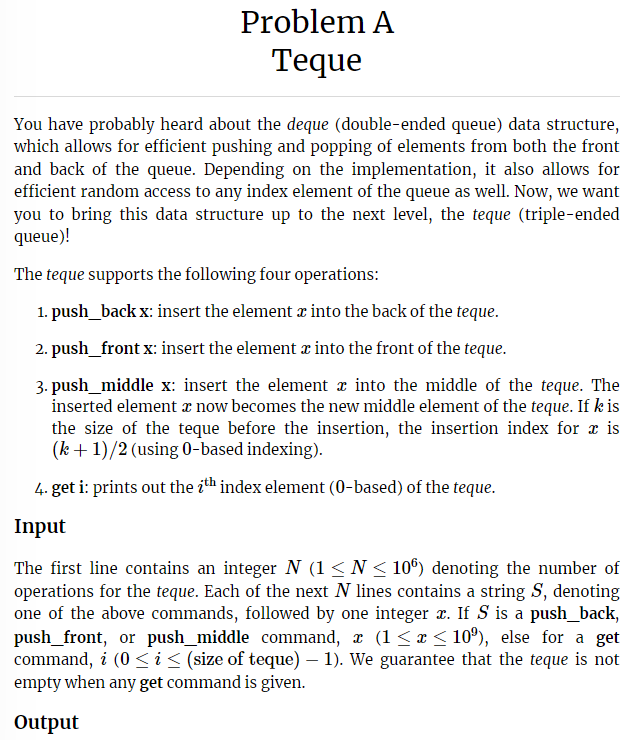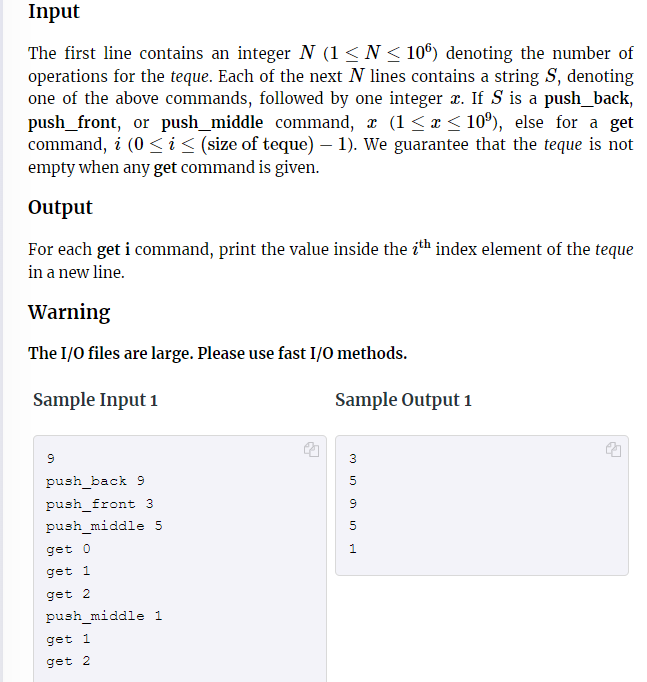Teque You have probably heard about the deque (double-ended queue) data structure, which allows for efficient pushing and popping of elements from both the front and back of the queue. Depending on the implementation, it also allows for efficient random access to any index element of the queue as well. Now, we want you to bring this data structure up to the next level, the teque (triple-ended queue)! The teque supports the following four operations: 1. push_back x: insert the element into the back of the teque. 2. push_front x: insert the element into the front of the teque. 3. push_middle x: insert the element into the middle of the teque. The inserted element à now becomes the new middle element of the teque. If k is the size of the teque before the insertion, the insertion index for x is (k+1)/2 (using 0-based indexing). 4. get i: prints out the ith index element (0-based) of the teque. Input
Teque You have probably heard about the deque (double-ended queue) data structure, which allows for efficient pushing and popping of elements from both the front and back of the queue. Depending on the implementation, it also allows for efficient random access to any index element of the queue as well. Now, we want you to bring this data structure up to the next level, the teque (triple-ended queue)! The teque supports the following four operations: 1. push_back x: insert the element into the back of the teque. 2. push_front x: insert the element into the front of the teque. 3. push_middle x: insert the element into the middle of the teque. The inserted element à now becomes the new middle element of the teque. If k is the size of the teque before the insertion, the insertion index for x is (k+1)/2 (using 0-based indexing). 4. get i: prints out the ith index element (0-based) of the teque. Input
Database System Concepts
7th Edition
ISBN:9780078022159
Author:Abraham Silberschatz Professor, Henry F. Korth, S. Sudarshan
Publisher:Abraham Silberschatz Professor, Henry F. Korth, S. Sudarshan
Chapter1: Introduction
Section: Chapter Questions
Problem 1PE
Related questions
Question
CODE IN JAVA
You have probably heard about the deque (double-ended queue) data structure, which allows for efficient pushing and popping of elements from both the front and back of the queue. Depending on the implementation, it also allows for efficient random access to any index element of the queue as well. Now, we want you to bring this data structure up to the next level, the teque (triple-ended queue)!

Transcribed Image Text:Problem A
Teque
You have probably heard about the deque (double-ended queue) data structure,
which allows for efficient pushing and popping of elements from both the front
and back of the queue. Depending on the implementation, it also allows for
efficient random access to any index element of the queue as well. Now, we want
you to bring this data structure up to the next level, the teque (triple-ended
queue)!
The teque supports the following four operations:
1. push_back x: insert the element æ into the back of the teque.
2. push_front x: insert the element à into the front of the teque.
3. push_middle x: insert the element into the middle of the teque. The
inserted element z now becomes the new middle element of the teque. If k is
the size of the teque before the insertion, the insertion index for a is
(k+1)/2 (using 0-based indexing).
4. get i: prints out the ith index element (0-based) of the teque.
Input
The first line contains an integer N (1 ≤ N≤ 106) denoting the number of
operations for the teque. Each of the next N lines contains a string S, denoting
one of the above commands, followed by one integer x. If S is a push_back,
push_front, or push_middle_command, x (1 ≤ x ≤ 10º), else for a get
command, i (0 ≤ i ≤ (size of teque) — 1). We guarantee that the teque is not
empty when any get command is given.
Output

Transcribed Image Text:Input
The first line contains an integer N (1 ≤ N ≤ 106) denoting the number of
operations for the teque. Each of the next N lines contains a string S, denoting
one of the above commands, followed by one integer x. If S is a push_back,
push_front, or push_middle command, x (1 ≤ x ≤ 10%), else for a get
command, i (0 ≤ i ≤ (size of teque) — 1). We guarantee that the teque is not
empty when any get command is given.
Output
For each get i command, print the value inside the ith index element of the teque
in a new line.
Warning
The I/O files are large. Please use fast I/O methods.
Sample Input 1
9
push_back 9
push_front 3
push_middle 5
get 0
get 1
get 2
push_middle 1
get 1
get 2
Sample Output 1
min
3
5
SINH
9
5
1
→
Expert Solution
This question has been solved!
Explore an expertly crafted, step-by-step solution for a thorough understanding of key concepts.
This is a popular solution!
Trending now
This is a popular solution!
Step by step
Solved in 4 steps with 2 images

Knowledge Booster
Learn more about
Need a deep-dive on the concept behind this application? Look no further. Learn more about this topic, computer-science and related others by exploring similar questions and additional content below.Recommended textbooks for you

Database System Concepts
Computer Science
ISBN:
9780078022159
Author:
Abraham Silberschatz Professor, Henry F. Korth, S. Sudarshan
Publisher:
McGraw-Hill Education

Starting Out with Python (4th Edition)
Computer Science
ISBN:
9780134444321
Author:
Tony Gaddis
Publisher:
PEARSON

Digital Fundamentals (11th Edition)
Computer Science
ISBN:
9780132737968
Author:
Thomas L. Floyd
Publisher:
PEARSON

Database System Concepts
Computer Science
ISBN:
9780078022159
Author:
Abraham Silberschatz Professor, Henry F. Korth, S. Sudarshan
Publisher:
McGraw-Hill Education

Starting Out with Python (4th Edition)
Computer Science
ISBN:
9780134444321
Author:
Tony Gaddis
Publisher:
PEARSON

Digital Fundamentals (11th Edition)
Computer Science
ISBN:
9780132737968
Author:
Thomas L. Floyd
Publisher:
PEARSON

C How to Program (8th Edition)
Computer Science
ISBN:
9780133976892
Author:
Paul J. Deitel, Harvey Deitel
Publisher:
PEARSON

Database Systems: Design, Implementation, & Manag…
Computer Science
ISBN:
9781337627900
Author:
Carlos Coronel, Steven Morris
Publisher:
Cengage Learning

Programmable Logic Controllers
Computer Science
ISBN:
9780073373843
Author:
Frank D. Petruzella
Publisher:
McGraw-Hill Education